A Glider View of the Spreading and Mixing Processes of Antarctic Intermediate Water in the Northeastern Subtropical Atlantic
Abstract
:1. Introduction
2. Data and Methods
2.1. Glider Section
2.2. Crossover Analysis
3. Results
3.1. AAIW Distribution along the Glider Section
3.2. AAIW Thermohaline Intrusions
4. Discussion and Conclusions
Author Contributions
Funding
Institutional Review Board Statement
Informed Consent Statement
Data Availability Statement
Acknowledgments
Conflicts of Interest
References
- Van Aken, H.M. The hydrography of the mid-latitude Northeast Atlantic Ocean II: The intermediate water masses. Deep-Sea Res. I Oceanogr. Res. Pap. 2000, 47, 789–824. [Google Scholar] [CrossRef]
- Herbaut, C.; Houssais, M.N. Response of the eastern North Atlantic subpolar gyre to the North Atlantic Oscillation. Geophys. Res. Lett. 2009, 36, 17607. [Google Scholar] [CrossRef]
- Pastor, M.V.; Peña-Izquierdo, J.; Pelegrí, J.L.; Marrero-Díaz, A. Meridional changes in water mass distributions off NW Africa during November 2007/2008. Cienc. Mar. 2012, 38, 223–244. [Google Scholar] [CrossRef] [Green Version]
- Bashmachnikov, I.; Nascimento, Â.; Neves, F.; Menezes, T.; Koldunov, N.V. Distribution of intermediate water masses in the subtropical northeast Atlantic. Ocean Sci. 2015, 11, 803–827. [Google Scholar] [CrossRef] [Green Version]
- Louarn, E.; Morin, P. Antarctic Intermediate Water Influence on Mediterranean Sea Water Outflow. Deep-Sea Res. I Oceanogr. Res. Pap. 2011, 58, 932–942. [Google Scholar] [CrossRef]
- Carracedo, L.I.; Pardo, P.C.; Flecha, S.; Pérez, F.F. On the Mediterranean Water Composition. J. Phys. Oceanogr. 2015, 46, 1339–1358. [Google Scholar] [CrossRef] [Green Version]
- Izquierdo, A.; Mikolajewicz, U. The role of tides in the spreading of Mediterranean Outflow waters along the southwestern Iberian margin. Ocean Model. 2019, 133, 27–43. [Google Scholar] [CrossRef]
- Tsuchiya, M. Circulation of the Antarctic Intermediate Water in the North Atlantic Ocean. J. Mar. Res. 1989, 47, 747–755. [Google Scholar] [CrossRef]
- Pérez, F.F.; Mintrop, L.; Llinas, O.; Glez-Davila, M.; Castro, C.G.; Alvarez, M.; Kortzinger, A.; Santana-Casiano, M.; Rueda, M.J.; Rıos, A.F. Mixing analysis of nutrients, oxygen and inorganic carbon in the Canary Islands region. J. Mar. Syst. 2001, 28, 183–201. [Google Scholar] [CrossRef] [Green Version]
- Carracedo, L.I.; Pardo, P.C.; Villacieros-Robineau, N.; de la Granda, F.; Gilcoto, M.; Pérez, F.F. Temporal changes in the water mass distribution and transports along the 20° W CAIBOX section (NE Atlantic). Cienc. Mar. 2012, 38, 263–286. [Google Scholar] [CrossRef]
- Machín, F.; Pelegrí, J.L. Northward penetration of Antarctic intermediate water off Northwest Africa. J. Phys. Oceanogr. 2009, 39, 512–535. [Google Scholar] [CrossRef] [Green Version]
- Roque, D.; Parras-Berrocal, I.M.; Bruno, M.; Sánchez-Leal, R.; Hernández-Molina, F.J. Seasonal variability of intermediate water masses in the Gulf of Cádiz: Implications of the Antarctic and subarctic seesaw. Ocean Sci. 2019, 15, 1381–1397. [Google Scholar] [CrossRef] [Green Version]
- Fu, Y.; Wang, C.; Brandt, P.; Greatbatch, R.J. Interannual variability of Antarctic Intermediate Water in the tropical North Atlantic. J. Geophy. Res. Ocean. 2019, 124, 4044–4057. [Google Scholar] [CrossRef]
- Huang, K.F.; Oppo, D.W.; Curry, W.B. Decreased influence of Antarctic intermediate water in the tropical Atlantic during North Atlantic cold events. Earth Planet. Sci. Lett. 2014, 389, 200–208. [Google Scholar] [CrossRef] [Green Version]
- Machín, F.; Pelegrí, J.L.; Fraile-Nuez, E.; Vélez-Belchí, P.; López-Laatzen, F.; Hernández-Guerra, A. Seasonal flow reversals of intermediate waters in the canary current system east of the Canary Islands. J. Phys. Oceanogr. 2010, 40, 1902–1909. [Google Scholar] [CrossRef] [Green Version]
- Hernández-Guerra, A.; López-Laatzen, F.; Machín, F.; Armas, D.; Pelegrí, J.L. Water masses, circulation and transport in the Eastern Boundary Current of the North Atlantic Subtropical Gyre. Sci. Mar. 2001, 65, 177–186. [Google Scholar] [CrossRef]
- Vélez-Belchí, P.; Caínzos, V.; Romero, E.; Casanova-Masjoan, M.; Arumí-Planas, C.; Santana-Toscano, D.; González-Santana, A.; Pérez-Hernández, M.D.; Hernández-Guerra, A. The Canary Intermediate Poleward Undercurrent: Not Another Poleward Undercurrent in an Eastern Boundary Upwelling System. J. Phys. Oceanogr. 2021, 51, 2973–2990. [Google Scholar] [CrossRef]
- Machín, F.J.; Pelegrí, J.L. Interaction of Mediterranean Water Lenses with Antarctic Intermediate Water off Northwest Africa. Sci. Mar. 2016, 80, 205–214. [Google Scholar] [CrossRef] [Green Version]
- Pascual-Collar, A.; Sotillo, M.; Levier, B.; Aznar, R.; Lorente, P.; Amo, A.; Álvarez-Fanjul, E. Regional circulation patterns of Mediterranean Outflow Water near the Iberian and African continental slopes. Ocean Sci. 2019, 15, 565–582. [Google Scholar] [CrossRef] [Green Version]
- Roemmich, D.; Boebel, O.; Freeland, H.; King, B.; LeTraon, P.T.; Molinari, R.; Owens, W.B.; Riser, S.; Send, U.; Takeuchi, K.; et al. On the Design and Implementation of Argo: An Initial Plan for a Global Array of Profiling Floats; International CLIVAR Project Office Report 21, GODAE Report 5; GODAE International Project Office: Melbourne, Australia, 1998; p. 32. [Google Scholar]
- Wong, A.; Wijffels, E.S.; Riser, C.S.; Pouliquen, S.; Hosoda, S.; Roemmich, D.; Gilson, J.; Johnson, C.G.; Martini, K.; Murphy, J.D.; et al. Argo Data 1999–2019: Two Million Temperature-Salinity Profiles and Subsurface Velocity Observations From a Global Array of Profiling Floats. Front. Mar. Sci. 2020, 7, 700. [Google Scholar] [CrossRef]
- Webb, D.C.; Simonetti, P.J.; Jones, C.P. SLOCUM: An underwater glider propelled by environmental energy. IEEE J. Ocean. Eng. 2001, 26, 447–452. [Google Scholar] [CrossRef]
- Woithe, H.C.; Kremer, U. Using Slocum Gliders for Coordinated Spatial Sampling. In OCEANS 2011 IEEE: Spain; IEEE: Santander, Spain, 2011; pp. 1–8. [Google Scholar] [CrossRef]
- Bosse, A.; Testor, P.; Mortier, L.; Prieur, L.; Taillandier, V.; d’Ortenzio, F.; Coppola, L. Spreading of Levantine Intermediate Waters by submesoscale coherent vortices in the northwestern Mediterranean Sea as observed with gliders. J. Geophys. Res. Ocean. 2015, 120, 1599–1622. [Google Scholar] [CrossRef] [Green Version]
- Garau, B.; Ruiz, S.; Zhang, W.G.; Pascual, A.; Heslop, E.; Kerfoot, J.; Tintoré, J. Thermal lag correction on slocum CTD glider data. J. Atmos. Ocean. Technol. 2011, 28, 1065–1071. [Google Scholar] [CrossRef] [Green Version]
- Lauvset, S.K.; Tanhua, T. A toolbox for secondary quality control on ocean chemistry and hydrographic data. Limnol. Oceanogr. Methods 2015, 13, 601–608. [Google Scholar] [CrossRef] [Green Version]
- Llinás, O.; Rueda, M.J.; Pérez-Marrero, J.; Pérez-Martell, E.; Santana, R.; Villagarcía, M.G.; Cianca, A.; Godoy, J.; Maroto, L. Variability of the Antarctic intermediate waters in the northern Canary box. Deep-Sea Res. II Trop. Stud. Oceanogr. 2002, 49, 3441–3453. [Google Scholar] [CrossRef]
- Desbruyères, D.; McDonagh, E.L.; King, B.A.; Thierry, V. Global and Full-Depth Ocean Temperature Trends during the Early Twenty-First Century from Argo and Repeat Hydrography. J. Clim. 2017, 30, 1985–1997. [Google Scholar] [CrossRef]
- Wong, A.; Keeley, R.; Carval, T.; Argo Data Management Team. Argo Quality Control Manual for CTD and Trajectory Data. p. 2022. Available online: https://archimer.ifremer.fr/doc/00228/33951/32470.pdf (accessed on 10 January 2023).
- Liu, M.; Tanhua, T. Water masses in the Atlantic Ocean: Characteristics and distributions. Ocean Sci. 2021, 17, 463–486. [Google Scholar] [CrossRef]
- Harvey, J. θ-S relationship and water masses in the eastern North Atlantic. Deep-Sea Res. 1982, 29, 1021–1033. [Google Scholar] [CrossRef]
- Ríos, A.F.; Pérez, F.F.; Fraga, F. Water masses in the upper and middle North Atlantic Ocean east of the Azores. Deep-Sea Res. Part II 1992, 39, 645–658. [Google Scholar] [CrossRef] [Green Version]
- Ruddick, B.; Phillips, O.M.; Turner, J.S. A laboratory and quantitative model of finite-amplitude thermohaline intrusions. Dyn. Atmos. Ocean. 1999, 30, 71–99. [Google Scholar] [CrossRef]
- May, B.; Kelley, D. Growth and steady state stages of thermohaline intrusions in the Arctic Ocean. J. Geophys. Res. 2001, 106, 16783–16794. [Google Scholar] [CrossRef]
- Ruddick, B.; Richards, K. Oceanic thermohaline intrusions: Observations. Prog. Oceanogr. 2003, 56, 499–527. [Google Scholar] [CrossRef]
- Shcherbina, A.Y.; Gregg, M.C.; Alford, M.H.; Harcourt, R.R. Characterizing Thermohaline Intrusions in the North Pacific Subtropical Frontal Zone. J. Phys. Oceanogr. 2009, 39, 2735–2756. [Google Scholar] [CrossRef]
- Rudels, B.; Kuzmina, N.; Schauer, U.; Stipa, T.; Zhurbas, V. Double-Diffusive Convection and Interleaving in the Arctic Ocean-Distribution and Importance. Geophysica 2009, 45, 199–213. [Google Scholar]
- Pietri, A.; Testor, P.; Echevin, V.; Chaigneau, A.; Mortier, L.; Eldin, G.; Grados, C. Finescale Vertical Structure of the Upwelling System off Southern Peru as Observed from Glider Data. J. Phys. Oceanogr. 2013, 43, 631–646. [Google Scholar] [CrossRef]
- You, Y. A global ocean climatological atlas of the Turner angle: Implications for double-diffusion and water-mass structure. Deep-Sea Res. I Oceanogr. Res. Pap. 2002, 49, 2075–2093. [Google Scholar] [CrossRef]
- Ruddick, B.R.; Gargett, E.A. Oceanic double-infusion: Introduction. Prog. Oceanogr. 2003, 56, 381–393. [Google Scholar] [CrossRef]
- Ruddick, B.R. A practical indicator of the stability of the water column to double-diffusive activity. Deep-Sea Res. I Oceanogr. Res Pap. 1983, 30, 1105–1107. [Google Scholar] [CrossRef]
- Rintoul, R.S. South Atlantic interbasin exchange. J. Geophys. Res. 1991, 96, 2675–2692. [Google Scholar] [CrossRef]
- Schmitz, W.J.; McCartney, M.S. On the North Atlantic circulation. Rev. Geophys. 1993, 31, 29–49. [Google Scholar] [CrossRef]
- Xie, R.C.; Marcantonio, F.; Schmidt, M.W. Deglacial variability of Antarctic intermediate water penetration into the North Atlantic from authigenic neodymium isotope ratios. Paleoceanogra 2012, 27, PA3221. [Google Scholar] [CrossRef]
- Jan, S.; Wang, S.H.; Yang, K.C.; Yang, Y.J.; Chang, M.H. Glider observations of interleaving layers beneath the Kuroshio primary velocity core east of Taiwan and analyses of underlying dynamics. Sci. Rep. 2019, 9, 11401. [Google Scholar] [CrossRef] [PubMed] [Green Version]
- Smyth, W.D.; Ruddick, B. Effects of Ambient Turbulence on Interleaving at a Baroclinic Front. J. Phys. Oceanogr. 2010, 40, 685–712. [Google Scholar] [CrossRef]
- Gutknecht, E.; Reffray, G.; Mignot, A.; Dabrowski, T.; Sotillo, M.G. Modelling the marine ecosystem of Iberia–Biscay–Ireland (IBI) European waters for CMEMS operational applications. Ocean Sci. 2019, 15, 1489–1516. [Google Scholar] [CrossRef] [Green Version]
- Sotillo, M.G.; Cailleau, S.; Lorente, P.; Levier, B.; Aznar, R.; Reffray, G.; Amo-Baladrón, A.; Chanut, J.; Benkiran, M.; Álvarez-Fanjul, E. The MyOcean IBI Ocean forecast andreanalysis systems: Operational products and roadmap to the future Copernicus Service. J. Operat. Oceanogr. 2015, 8, 63–79. [Google Scholar] [CrossRef]


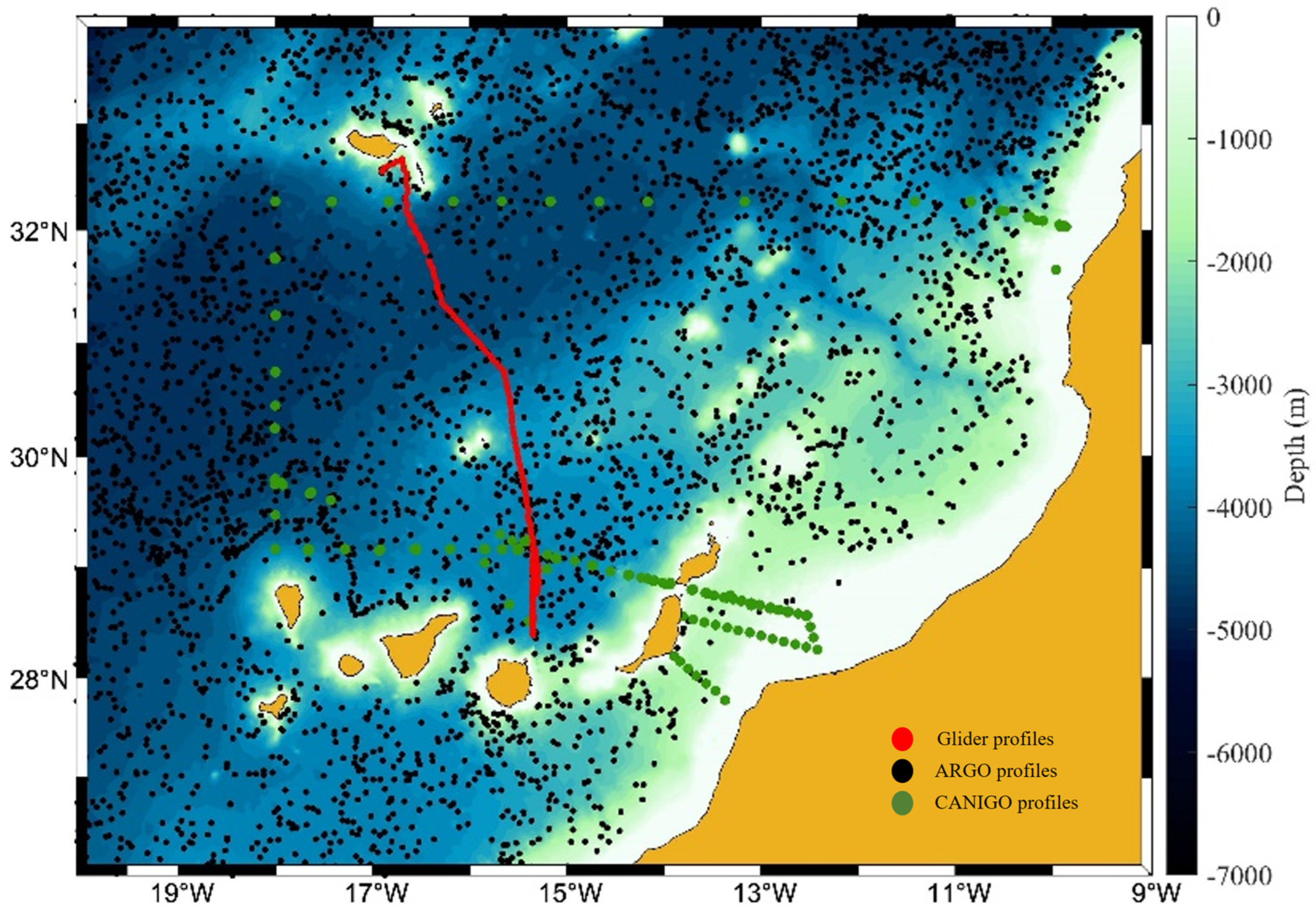
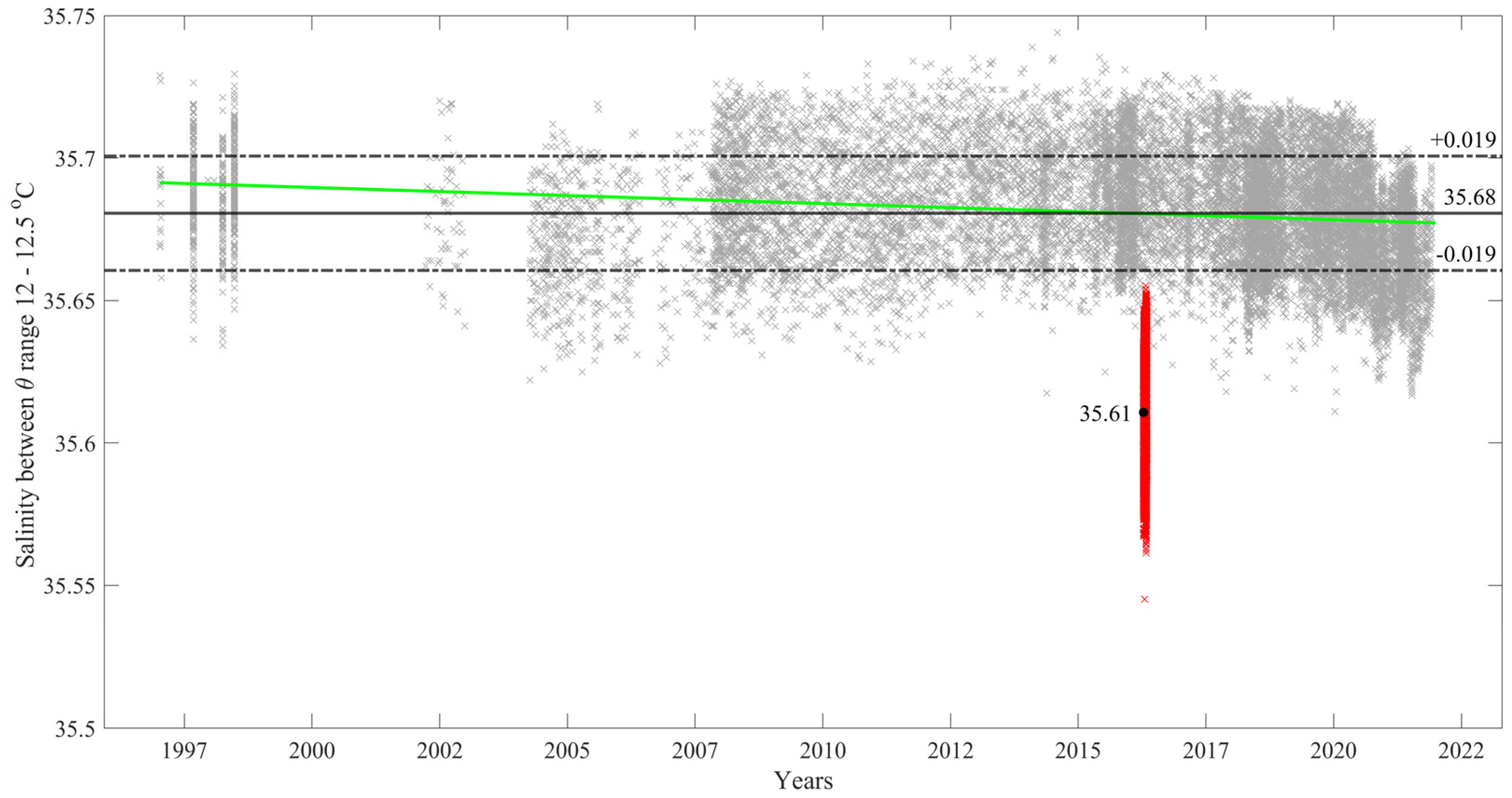


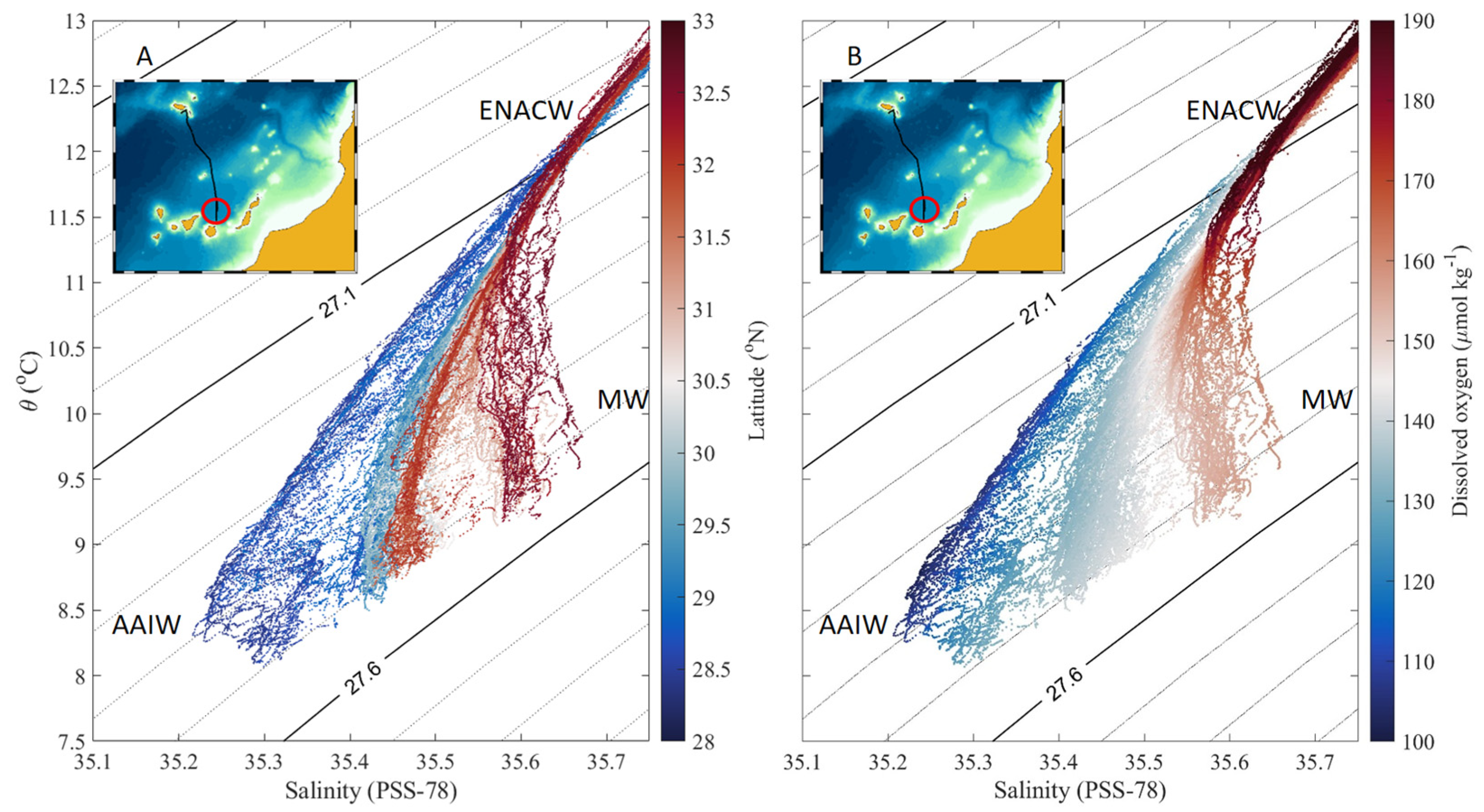
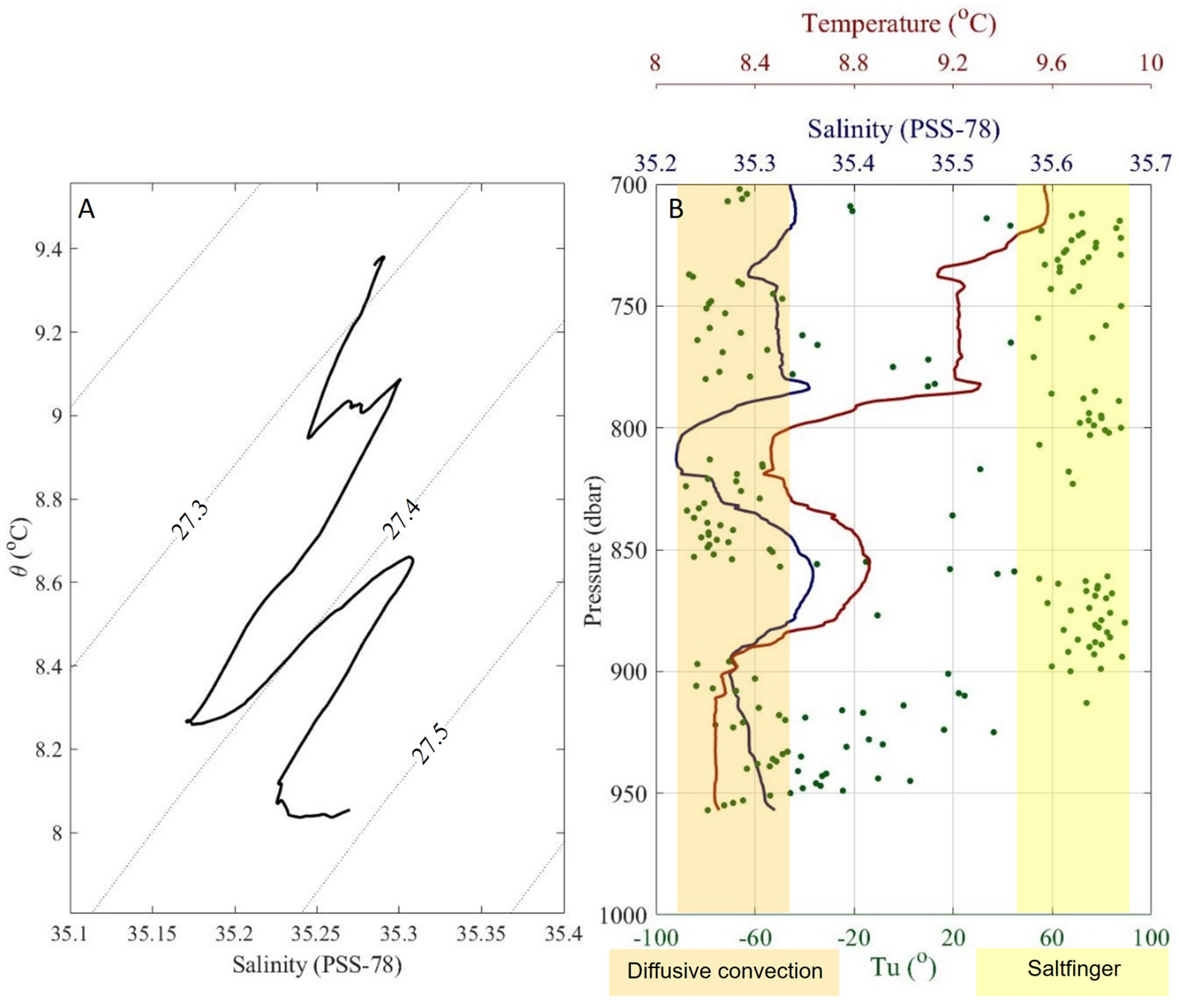
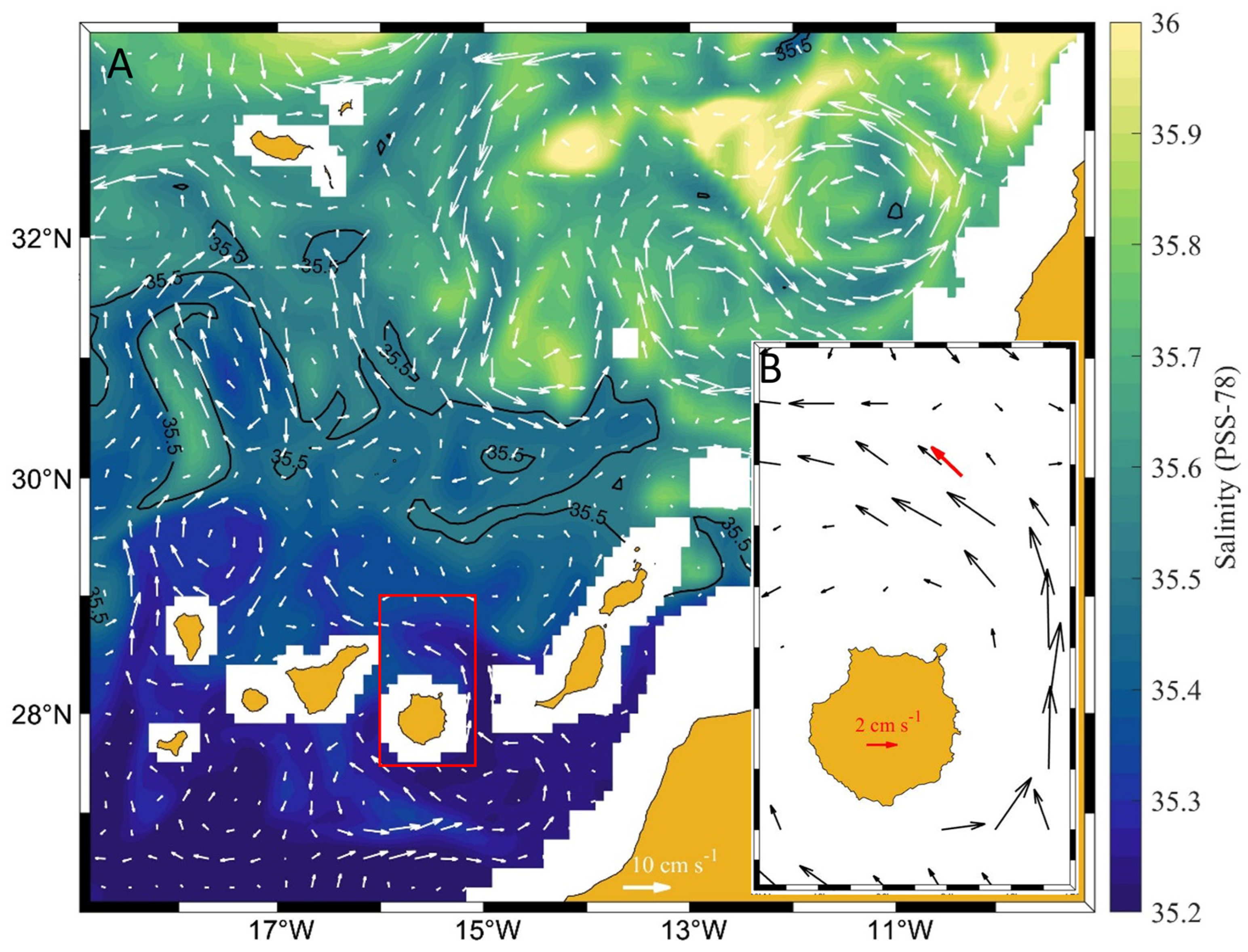
| Platform | Mission | Period | Number of Profiles |
|---|---|---|---|
| R/V Meteor | 37 | 6–22 January 1997 | 10 |
| R/V Poseidon | 233/A | 5–21 September 1997 | 17 |
| R/V Poseidon | 237/A | 2–17 April 1998 | 11 |
| R/V Meteor | 42 | 26 June–16 July 1998 | 37 |
| ARGO floats | ARGO program | 2002–2021 | 699 |
Disclaimer/Publisher’s Note: The statements, opinions and data contained in all publications are solely those of the individual author(s) and contributor(s) and not of MDPI and/or the editor(s). MDPI and/or the editor(s) disclaim responsibility for any injury to people or property resulting from any ideas, methods, instructions or products referred to in the content. |
© 2023 by the authors. Licensee MDPI, Basel, Switzerland. This article is an open access article distributed under the terms and conditions of the Creative Commons Attribution (CC BY) license (https://creativecommons.org/licenses/by/4.0/).
Share and Cite
Jiménez-Rincón, J.A.; Cianca, A.; Ferrero-Martín, C.; Izquierdo, A. A Glider View of the Spreading and Mixing Processes of Antarctic Intermediate Water in the Northeastern Subtropical Atlantic. J. Mar. Sci. Eng. 2023, 11, 576. https://doi.org/10.3390/jmse11030576
Jiménez-Rincón JA, Cianca A, Ferrero-Martín C, Izquierdo A. A Glider View of the Spreading and Mixing Processes of Antarctic Intermediate Water in the Northeastern Subtropical Atlantic. Journal of Marine Science and Engineering. 2023; 11(3):576. https://doi.org/10.3390/jmse11030576
Chicago/Turabian StyleJiménez-Rincón, Juan Alberto, Andrés Cianca, Carmen Ferrero-Martín, and Alfredo Izquierdo. 2023. "A Glider View of the Spreading and Mixing Processes of Antarctic Intermediate Water in the Northeastern Subtropical Atlantic" Journal of Marine Science and Engineering 11, no. 3: 576. https://doi.org/10.3390/jmse11030576





